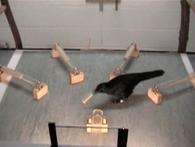Crows can use 'up to three tools'

(PhysOrg.com) -- New experiments by Oxford University scientists reveal that New Caledonian crows can spontaneously use up to three tools in the correct sequence to achieve a goal, something never before observed in non-human animals without explicit training.
Sequential tool use has often been interpreted as evidence for advanced cognitive abilities, such as planning and analogical reasoning, but this has never been explicitly examined.
The researchers set out to investigate what the crows really understood about the tasks and their own actions with tools. A report of their research appears in this week’s edition of the open-access journal PLoS One.
In the wild, New Caledonian crows use a range of tool types for extracting invertebrate prey from holes and crevices, and in captivity, they have been shown to make, or select, tools to retrieve food rewards. In previous experiments, the Oxford team reported that a crow (named ‘Betty’) was capable of spontaneously inventing new tool designs according to what was required by the tasks. In all these cases, however, objects were used to act on pieces of food.
This video was made during previous experiments. In the Brevia section of the 9 August 2002 issue of Science, Weir et al. report a remarkable observation: The toolmaking behavior of New Caledonian crows. In the experiments, a captive female crow, confronted with a task that required a curved tool (retrieving a food-containing bucket from a vertical pipe), spontaneously bent a piece of straight wire into a hooked shape -- and then repeated the behavior in nine out of ten subsequent trials.
Using tools to act on non-food objects - for example, to make or retrieve other tools - is considered to be a hallmark of human intelligence, and may have been a crucial step in our evolution. One form of this behaviour, ‘sequential tool use,’ has been observed in a number of non-human primates, and has recently been reported for New Caledonian crows by a research team from Auckland University, New Zealand.
In their new study, the Oxford scientists tested seven captive New Caledonian crows on a range of tasks requiring the use of up to three different tools in a sequence to retrieve food. Five crows successfully used tools in a sequence (four from their very first trial), and four repeatedly solved the most demanding three-tool condition. In this, food was placed at a depth so that it was only reachable with one particular tool, but getting that tool required the use of two other others. The crows had to use a short, available tool to drag in a longer, otherwise out-of-reach tool, and then use that longer tool to retrieve the correct, longest one. They could then use the longest tool to reach for the food morsel.
Pre-training on each element in the sequence was not required for successful sequential tool use - an explanation that could not be ruled out in earlier studies on primates and crows. Painstaking analysis of tool choices, tool swapping and improvement over time allowed the team to conclude that successful crows did not probe for tools at random: for example, when birds swapped tools, it was usually to get a longer one. At the same time, however, they could find no firm evidence to support previous claims that sequential tool use demonstrates analogical reasoning or human-like planning.
While the ability of crows to use three tools in sequence reveals a competence beyond that observed in any other non-human species, including non-human primates, this study also emphasises the importance of a cautious approach in comparative cognitive science. Seemingly intelligent behaviour can be achieved without the involvement of high-level mental faculties, and detailed analyses are necessary before accepting claims for complex cognitive abilities.
Provided by Oxford University (news : web)

















